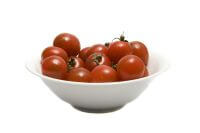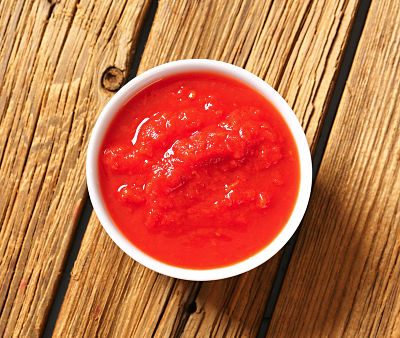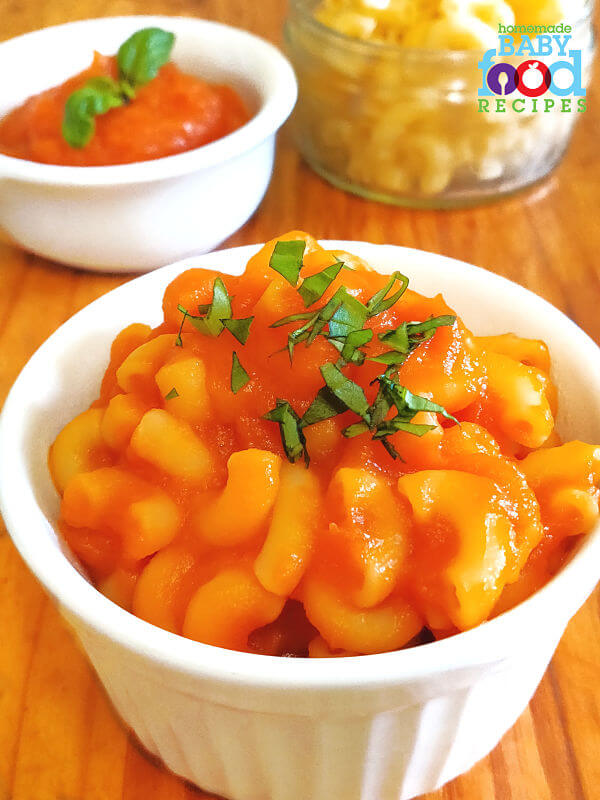Tomato Baby Food Recipes and Tips
Updated: Aug 21, 2023
Welcome to our Tomato Baby Food Recipes section, where we answer all your questions about when and how to introduce tomatoes to your little one.
Tomatoes are one of those foods that you may be unsure about giving to your baby.
You’ve probably heard that they are allergenic and should be avoided – yet you’ve probably seen jars of baby food in the grocery store that are made with tomato (particularly ‘pasta dinners’).
So let’s look at just why some resources suggest avoiding tomatoes – and how to cook them for your baby when it’s time to include them in his menu!

When can my baby eat tomatoes?
The general ‘rule’ is to wait until late in baby’s first year – from around 10 months of age – to introduce tomatoes.
The reason for this is that tomatoes sometimes cause skin reactions in babies.
The most common seems to be diaper rash (or nappy rash) following a meal containing tomatoes – but some parents also find that they can cause a rash around baby’s mouth.
Tomatoes are quite acidic, so these reactions may be a result of this acidity – or they could be due to a tomato intolerance, which may also cause wheezing or vomiting.
True tomato allergy – which can be life threatening – is actually quite rare, although a proper diagnosis can only be made by your child’s doctor.
You should – of course – seek advice from a medical professional before introducing tomatoes to your baby and if you are concerned that he may be experiencing any type of reaction to tomatoes.
Some asthma sufferers report that their symptoms are made worse by eating tomatoes – so you may well choose to introduce them later rather than sooner if your little one has any existing respiratory issues.
Tomatoes are also sometimes blamed for eczema flare-ups and – because of their acidity – may also aggravate infant reflux.
If your baby has either of these conditions, be sure to discuss your concerns carefully with your child’s doctor.
Remember to follow the four day rule when introducing tomatoes, so that you will be able to quickly identify them as the cause should your baby experience any adverse reaction or digestive issues.
WE DON’T RECOMMEND OFFERING RAW TOMATOES TO YOUR BABY.
An interesting point about reactions to tomatoes – particularly reactions in the skin – is that they tend to be caused more often by raw tomatoes than cooked.
This is probably because the protein responsible for the reaction breaks down during the cooking process.
In fact, there are individuals who have to completely avoid raw tomatoes, but who can enjoy pasta sauces and other foods containing processed tomatoes.
Furthermore, some people may react to certain types of tomatoes and not others, although you should check with your doctor before offering a different variety of tomato if your baby has already reacted badly to one particular type.
Some babies may enjoy tomatoes earlier than 10 months of age…
In fact, we are big pasta fans and our little ones have always been introduced to tomato based pasta sauces from around 7 months of age.
It is, of course, for you and your doctor to decide when is the most appropriate time to introduce tomatoes to YOUR little one, particularly if he is at an increased risk of food allergy (if there is a family history of allergy, for example) or if he suffers from any of the conditions mentioned above.
The nutritional value of tomatoes
It almost goes without saying that tomatoes are a healthy addition to baby’s diet and contain many nutrients, including…
Tomatoes are also a rich source of anti-oxidants – and one anti-oxidant in particular, lycopene, has been proven to be extremely useful to the human body!
Lycopene helps provide protection against serious diseases like cancer and heart disease – and it has also been shown to offer protection against the sun’s harmful UV rays.
And here’s a great bonus for us parents… the same research demonstrated that regularly consuming tomatoes boosts your levels of a molecule called procollagen, which keep the skin firm and helps prevent wrinkles!
Your baby can absorb the lycopene much more easily from cooked tomatoes than from raw.
Because the concentration of lycopene is intensified by processing, experts recommend products like tomato paste, tomato sauce, canned tomatoes, tomato puree and even ketchup as particularly rich sources (although tests have shown that organic ketchup is better!).
Whilst we’re not suggesting that you slather your baby’s meals with ketchup, it’s useful to know for the future that – unusually – processing actually makes THIS particular food MORE nutritious!
NOTE: If using canned tomatoes, look for those that include peel, as their nutritional value will be higher.
Try serving tomatoes with fatty foods…
…like avocado, olive oil or fatty fish (e.g. tuna and salmon).
Why?
Because the lycopene in the tomatoes is fat soluble – meaning that it is more easily absorbed into the body when served along with these healthy fats!
Tomatoes help your baby absorb more iron from other foods….
This is because they are rich in vitamin C, a nutrient that aids iron absorption.
What’s more, cooking tomatoes and meat (a good source of iron) in an iron cooking pot boosts the iron content of the food even more.
This is due to the acidity of the tomatoes, which ‘draws’ the iron from the pot and into the food.
WARNING:
DON’T cook tomatoes in aluminium cookware.
Their acidity will cause the aluminium to migrate into the food, which – unlike iron – is NOT a healthy addition.
Choosing and storing tomatoes for your baby food recipes
There are so many varieties of tomato available – from little cherry tomatoes to huge beefsteak tomatoes – that it might be difficult to decide on the best type for your little one!
We like to use sweet-tasting tomatoes in our baby food recipes and to avoid tart ones altogether – so we often cook with grape tomatoes (which we think are the sweetest of all) or cherry tomatoes.
Our little ones enjoy plum tomatoes, too, which have a great texture for cooking and make really rich and tasty sauces!
If possible, buy ‘vine ripened’ tomatoes.
It’s not just a marketing gimmick – they are actually much tastier, because they’ve been allowed to ripen naturally.
This is opposed to ‘regular’ tomatoes, which are often picked when still green and treated with ethylene gas to ripen them.
Unsurprisingly, this unnatural interference leaves them sorely lacking – in taste AND texture – whereas vine-ripened tomatoes are sweet and bursting with flavour!
Look for deep, red tomatoes (which are visibly packed with those wonderful lycopenes), with a medium-firm texture and no blemishes.
If you can’t find ripe tomatoes, then ripen them yourself at home by placing them in a brown paper bag – if you throw in another piece of fruit (like a banana or an apple) then they will ripen even faster.
Do NOT place them in the sun to ripen.
Whether ripe or unripe, always store your tomatoes at room temperature – not in the fridge.
Refrigerating tomatoes stops the ripening process and adversely affects both their flavour AND their texture.
Once ripe, tomatoes should keep for several days.
How to peel a tomato
We prefer to leave the skins on the tomatoes we use in our baby food recipes – partly because they add nutritional value… and partly because it’s easier!
They become extremely soft during cooking and our little ones have always managed them without difficulty.
That being said, we use organic tomatoes, which we really recommend if you can get them!
They always seem to taste better and there are no worries about pesticide residues or wax (please see this page for more information – Should I Peel Fruits and Vegetables for Baby?).
If you DO choose to peel tomatoes for use in your baby food recipes, there are several methods you can use.
- Boil a small pan of water.
- Lower in your tomatoes – 2 at a time – and boil for 15-30 seconds.
- Plunge into a bowl of cold water, then pierce with a knife. The skins will slide right off. (Note: Don’t boil the tomatoes for any longer than 30 seconds, or they will begin to cook. This means they’ll turn mushy – and be even harder to peel!).
OR
Put the tomato on to a fork and hold it in an open gas flame, turning slowly until it’s charred all over. Remove from the flame and cool – and the skins should come off easily!
OR
Use a ‘purpose built’ soft skin peeler.
Tomato baby food recipes
A simple tomato sauce made from fresh tomatoes is easy to prepare and can be used for all sorts of things, from a sauce for pasta to a topping or dip for cooked veggies!
You can make a very basic sauce by merely sauteing fresh, chopped tomatoes in olive oil until they ‘break down’ – and you can pep it up a little by adding some fresh, chopped basil. Delicious!
Here’s a slightly more sophisticated method we use that brings out the sweetness of the tomatoes and garlic and tastes sublime…
Homemade Oven Roasted Tomato Sauce
6 plum tomatoes
1 bulb garlic (unpeeled)
1 onion
olive oil
2 tbsp chopped, fresh basil
- Preheat the oven to 400 deg F, 200 deg C.
- Cut the tomatoes in half lengthwise and squeeze gently to remove the seeds.
- Place in a shallow baking tray and drizzle with olive oil.
- Cut the top off the garlic bulb (so you can just see the garlic inside the cloves) and place next to the tomatoes. Drizzle with olive oil.
- Peel the onion, cut into wedges and toss in olive oil. Place in the baking tray with the tomatoes and garlic.
- Bake for around 45 mins to 1 hour, until the onion is tender and the tomatoes are completely soft and broken down
- Place the tomatoes and onion in a blender and squeeze in the garlic (which should now be creamy) from each clove. Add as much or as little as your baby will enjoy. Blend until smooth.
- Before serving, stir in a little extra olive oil and the fresh, chopped basil.
- Serve with pasta, or as a delicious tomato base for pizza (we have a wonderful recipe for a sweet potato pizza base on our Sweet Potato Baby Food Recipes page).
Oven Roasted Tomato Soup
Rather than using a separate recipe, we prepare a tasty soup by using our homemade oven roasted tomato sauce!
A real time-saver is to double the quantities shown above, then use half the sauce for the soup and the other half as a pasta sauce (it freezes very well, so there’s no need to use everything all at once!).
Making the soup requires a slight adjustment to the recipe shown above… when blending the ingredients in the food processor, add enough low sodium or homemade chicken stock to achieve the desired consistency.
We then like to add a little cream to create a smooth and appealing texture!
Simple Stuffed Tomato
1 medium tomato
2 small, cooked broccoli florets
2 tsp grated Cheddar cheese
2 heaped tsp fresh, whole wheat breadcrumbs
1/2 tsp chopped, fresh parsley
2 tsp grated Parmesan cheese
1 tbsp apple juice
- Preheat the oven to 350 deg F (180 deg C).
- Cut off the top of the tomato and scoop out the flesh with a spoon, leaving the ‘shell’ intact.
- Turn upside down, place on a kitchen towel and set aside for 30 mins – this drains out the excess moisture.
- Meanwhile, chop the broccoli finely. Mix with the cheese, breadcrumbs, parsley and apple juice.
- Fill the tomato shell with the mixture and top with the Parmesan cheese. Bake for around 30 mins, until the tomato is tender and the cheese is golden.



